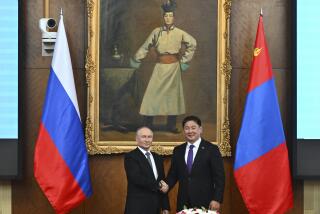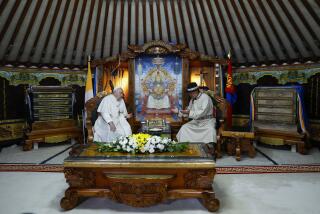Looking up a gift horse in Mongolian plains
- Share via
ULAN BATOR, MONGOLIA — On a sunny fall day in 2005, Donald H. Rumsfeld arrived in Mongolia. The nation was delighted: He was the first U.S. Defense secretary to visit.
To celebrate, the Mongolian government gave Rumsfeld a horse.
Mongolians say they have about 400 words to describe the details of a horse’s look and character -- 36 words just for galloping -- but American reporters preferred to describe the gift as the color of a “latte.”
Rumsfeld, in a gray suit and blue tie, awkwardly guided the horse through a few paces and gave it an American name -- Montana -- because, he said, Mongolia’s expanses reminded him of his wife’s home state. Transporting the horse home, however, posed a problem.
So, per custom, Rumsfeld entrusted one of Mongolia’s nomadic herders to care for the mount until he could return.
I thought I should check on the horse. Rumsfeld is no longer in office, so who knows when he will get to Mongolia again. I was going anyway, so I planned to give the beast a once-over and gather the herder’s thoughts on Rumsfeld, the U.S. and Iraq.
Mongolian troops, after all, are on their seventh tour in Iraq. And because Mongolia has only 2.8 million people, its contingent of more than 100 soldiers makes the country the coalition’s third-largest contributor on a per-capita basis.
To find the horse, I enlisted the help of Ganbat Namjilsangarav, a 33-year-old journalist and guide who learned English while working as a roughneck for an oil company.
“We should start with the Ministry of Defense,” he said, as we bumped along in a sport utility vehicle through the capital, Ulan Bator.
The cityscape unfolded like a fossil record of Mongolia’s political history. There was the mammoth statue of a seated Genghis Khan, looking every bit the imperious conqueror who brought Mongolia to the height of its power in the 13th century. Down the street, an iron Lenin in a sport coat still stands in testament to Mongolia’s close ties to the Soviet Union for 70 years.
Then there are the city’s newest monuments: cranes looming over scores of construction sites. Many belong to contractors from China. Others are paid for by trade with China, signs of the latest boom in Mongolia’s relations with its giant neighbor to the south.
When you are landlocked on the lonesome plains of Asia, it pays to be welcoming. Mongolia graciously calls the United States its “third neighbor.” It bestows the same honorific on Japan and Europe.
My guide, Ganbat, made one call after another. Each ministry referred us to someone else. We crisscrossed downtown on foot. Hours passed.
We were about to give up when Ganbat reached Gen. Bayar Batzorig, the head of foreign relations at the Defense Ministry. He knew about the horse.
“You know,” the general told me in perfect English, “that herder is a nomad. I’m afraid he might be very far away right now.” He would see what he could do, he said.
In the days that followed, Ganbat and I traveled back and forth across the vast flat plains of central Mongolia. We spent the night in Arvaikheer, a town named for an especially fast horse. We passed herd after herd of horses grazing on the steppe. Each time, I wondered if one of them was Rumsfeld’s.
Everywhere we went, we asked people about Rumsfeld’s horse. The Defense secretary had come to thank Mongolia for its help in Iraq and Afghanistan. Mongolia was one of 38 countries with troops in Iraq shortly after the invasion. Today, the coalition is down to 25 countries, according to the Council on Foreign Relations, but Mongolia is still one of them.
Few people knew much about the war -- it has drifted to the back pages of Mongolian newspapers -- but everyone seemed to have experience in giving or receiving livestock.
“I was promised a cow at my wedding,” said Oyungerel Tsedevdamba, the Stanford-trained advisor to the former prime minister. I tried to picture the cow roaming the quiet cul-de-sac of stucco homes where she lives. Young people nowadays rarely take possession of animals they are promised, Oyungerel explained.
“But my father always claims the animals he is given,” she continued. “I’ll call him and ask how many he has received. He will know.”
She dialed her 76-year-old father at his home in the remote north, a land of reindeer and shamanist tribes. She jotted down their conversation, scribbling and revising the tally as they went along.
“He has been given three cows that have produced two calves,” she said. “He has three cows that are getting ready to produce three calves. He has five sheep now. He was supposed to have 12, but two died from wolves and winter. He ate four. And he lost one” to thieves.
Gift horses have served Mongolia well. Foreign empires rise and fall, wars are won and lost, but the ritual endures. Old-timers at the Foreign Ministry remember giving horses to Soviet President Leonid Brezhnev and Romanian dictator Nicolae Ceausescu.
National leaders are not the only recipients. In 2004, a horse was given to Billy Downs, a visitor from Ferndale, Mich., who runs BD’s Mongolian Grill, a chain of restaurants that calls itself the “world’s number one Create Your Own Stir-Fry restaurant concept.”
Day after day, I scanned my e-mail for news from Gen. Bayar, but nothing came. Each cellphone ring carried a jolt of expectation, but the trail was growing cold.
On my penultimate day in town, Ganbat got a call. It was the general, and he had good news. He had found the horse. It was in Khentii province, birthplace of Genghis, about 200 miles east of Ulan Bator. The bad news: The horse could be anywhere in the province, an area the size of Austria.
I was out of time. But next time I am in Mongolia, the general said, I am welcome to keep seeking Rumsfeld’s horse.
More to Read
Sign up for Essential California
The most important California stories and recommendations in your inbox every morning.
You may occasionally receive promotional content from the Los Angeles Times.












